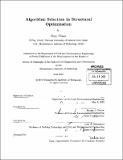Algorithm selection in structural optimization
Author(s)
Clune, Rory P. (Rory Patrick)
DownloadFull printable version (26.33Mb)
Other Contributors
Massachusetts Institute of Technology. Department of Civil and Environmental Engineering.
Advisor
Jerome J. Connor and John A. Ochsendorf.
Terms of use
Metadata
Show full item recordAbstract
Structural optimization is largely unused as a practical design tool, despite an extensive academic literature which demonstrates its potential to dramatically improve design processes and outcomes. Many factors inhibit optimization's application. Among them is the requirement for engineers-who generally lack the requisite expertise-to choose an optimization algorithm for a given problem. A suitable choice of algorithm improves the resulting design and reduces computational cost, yet the field of optimization does little to guide engineers in selecting from an overwhelming number of options. The goal of this dissertation is to aid, and ultimately to automate, algorithm selection, thus enhancing optimization's applicability in real-world design. The initial chapters examine the extent of the problem by reviewing relevant literature and by performing a short, empirical study of algorithm performance variation. We then specify hundreds of bridge design problems by methodically varying problem characteristics, and solve each of them with eight commonly-used nonlinear optimization algorithms. The resulting, extensive data set is used to address the algorithm selection problem. The results are first interpreted from an engineering perspective to ensure their validity as solutions to realistic problems. Algorithm performance trends are then analyzed, showing that no single algorithm outperforms the others on every problem. Those that achieve the best solutions are often computationally expensive, and those that converge quickly often arrive at poor solutions. Some problem features, such as the numbers of design variables and constraints, the structural type, and the nature of the objective function, correlate with algorithm performance. This knowledge and the generated data set are then used to develop techniques for automatic selection of optimization algorithms, based on a range supervised learning methods. Compared to a set of current, manual selection strategies, these techniques select the best algorithm almost twice as often, lead to better-quality solutions and reduced computational cost, and-on a randomly-chosen set of mass minimization problems-reduce average material use by 9.4%. The dissertation concludes by outlining future research on algorithm selection, on integrating these techniques in design software, and on adapting structural optimization to the realities of design. Keywords: Algorithm selection, structural optimization, structural design, machine learning
Description
Thesis (Ph. D.)--Massachusetts Institute of Technology, Department of Civil and Environmental Engineering, 2013. Cataloged from PDF version of thesis. Includes bibliographical references (pages 153-162).
Date issued
2013Department
Massachusetts Institute of Technology. Department of Civil and Environmental EngineeringPublisher
Massachusetts Institute of Technology
Keywords
Civil and Environmental Engineering.